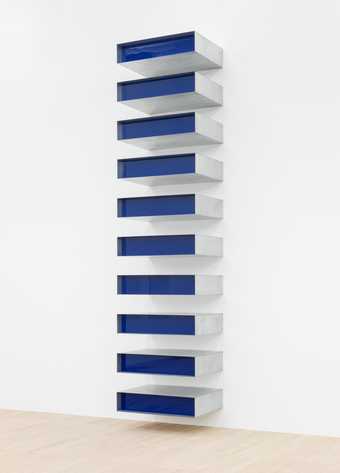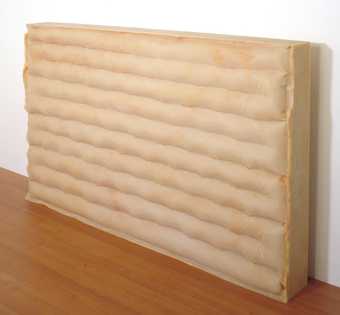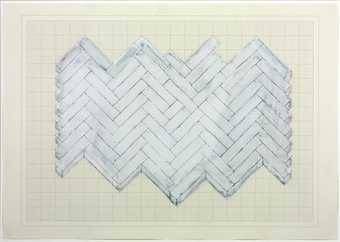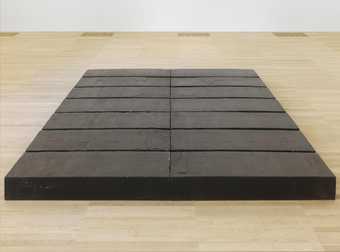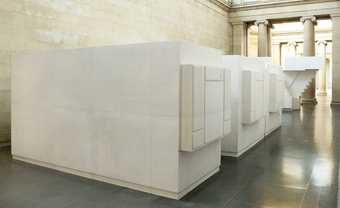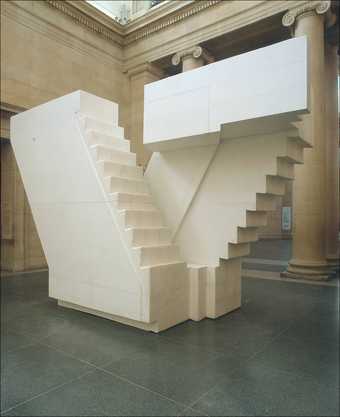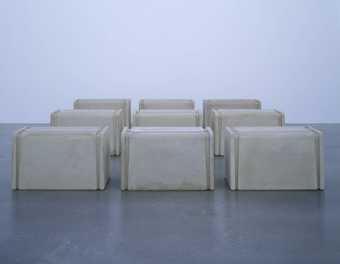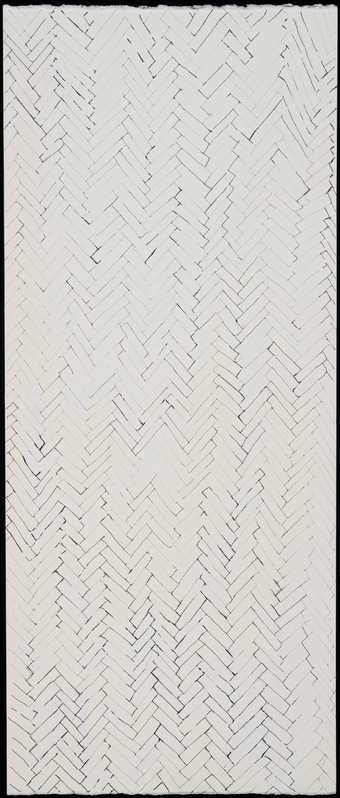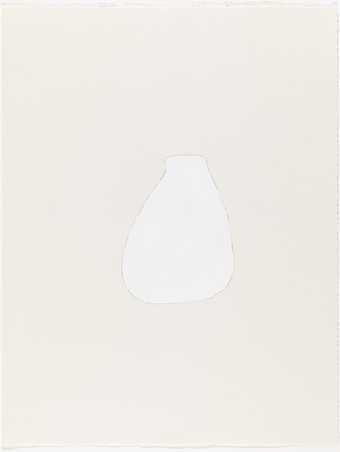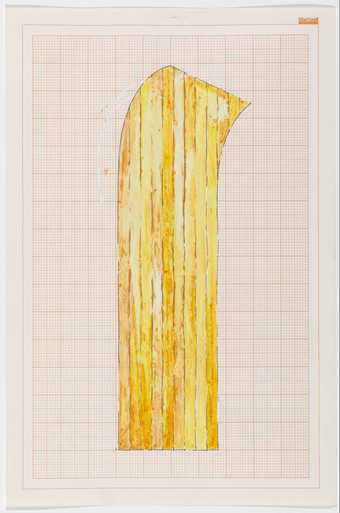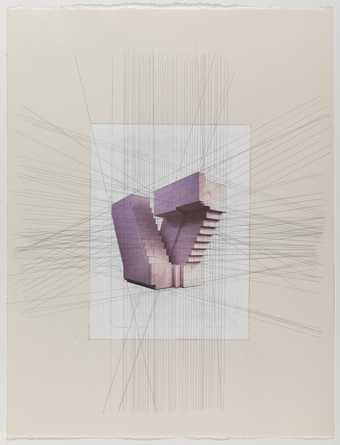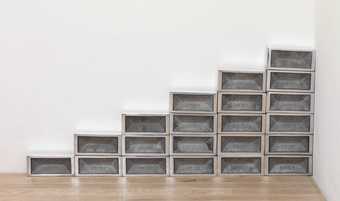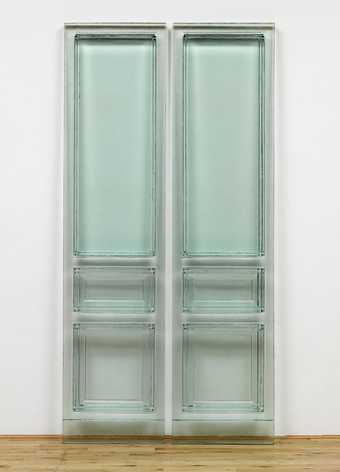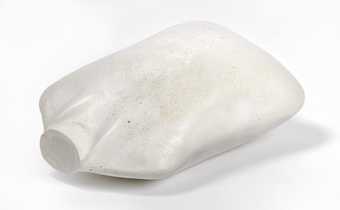
Not on display
- Artist
- Rachel Whiteread born 1963
- Medium
- Aluminium
- Dimensions
- Object: 263 × 203 × 60 mm
- Collection
- Tate
- Acquisition
- Purchased from funds provided by the Gytha Trust 2003
- Reference
- T07985
Summary
This wall-mounted sculpture was created by casting an electrical switch box. The process required to arrive at the finished object involved several stages of casting in both positive and negative. The face of the box is a negative cast – an imprint of the face of the original box, with negatives of the twenty-four switches and eight screw heads. Its body is a positive cast, a reproduction of the original body, including an indentation at the edge of the face around the sides where the plastic plate would have separated away from the walls on being unscrewed. After creating a mould which combined the negative face with the positive body, Whiteread cast the sculpture in aluminium, in an edition of twenty-four. Tate’s copy is the seventh in the edition.
Whiteread bases her practice on casting the negative and positive spaces inside and around everyday domestic objects and architectural entities. Her earliest cast objects were hot water bottles, wardrobes, mattresses, mortuary slabs and air beds such as Untitled (Air Bed II) 1992 (Tate T06731), followed by baths, sections of floor, such as Untitled (Floor) 1994-5 (Tate T07129), plinths, shelves of books and the spaces under chairs and tables. She has also cast entire rooms, Untitled (Rooms) 2001 (Tate T07938) and several staircases, such as Untitled (Stairs) 2001 (Tate T07939). Solid casts in plaster or concrete evoke bodies and mummification, the claustrophobic blocking out of empty space. Whiteread pioneered large-scale casting in first rubber and plastic, and later resin (previously these materials had only been used for casting on a small scale), to transform the original object and its associations. Yellow rubber and plastic casts frequently evoke bodily fluids, beeswax and lard; orange resin suggests amber; green and blue resin casts resemble glass and large bodies of water. Whiteread’s processes follow the tradition of Minimalism, in which reduction and abstraction are frequently coupled with seriality and repetition. In works like Untitled (Nine Tables) 1998 (Tate T07984) the cast of an object, in this case the space under a table, is repeated and installed in grid formation. In common with German artist Eva Hesse (1936-70), Whiteread uses industrial materials with organic associations. She has commented: ‘My works are very much connected with the body and with the human touch. Whether it’s my touch, or someone else’s, or a whole family’s touch, they’re about [an object] that has been used.’ (Quoted in Mullins, p.73.)
In Untitled (Twenty-Four Switches) the twenty-four switches on the box are set out in a regular grid comprising four rows of six. Each row is ornamented with the imprints of a screw head at either end. The positions of the thread of each screw head, like the on/off position of each switch, are in random order. The switch box thus presents an ordered grid in which there are random variables, disrupting the predictable with the unpredictable. In this work the human element – the unknown human hand turning the screwdriver and flicking the switches – has created a mysterious pattern for which there is no rationale. The sculpture may be read as an abstract composition in which the binary combination of the switches’ on/off positioning is echoed in the combination of positive and negative casting.
Further reading:
Charlotte Mullins, Rachel Whiteread, London 2004, reproduced p.118 in colour
Rachel Whiteread, exhibition catalogue, Anthony d’Offay Gallery, London 1998, reproduced p.2 and p.13 in colour
Rachel Whiteread: Shedding Life, exhibition catalogue, Tate Gallery, Liverpool 1996
Elizabeth Manchester
February 2005
Does this text contain inaccurate information or language that you feel we should improve or change? We would like to hear from you.
Technique and condition
One piece smooth surfaced sculpture of a ‘twenty four finger rocker’ electrical switch box, designed to be wall hung.
The sculpture would appear to be a lost wax cast made as one piece in 8 mm thick aluminium with, on the rear, an additional key whole slotted hanging bar, welded on after casting. The aluminium surface is naturally tarnished and has a burnished look. The face of the box has very small pitted areas which appear to be part of the casting process; the aluminium is brighter, where small areas have subsequent fills of aluminium inserted in casting imperfections.
On the front face of the box are the impressions of twenty four switches; four evenly spaced rows of six. The switches are ‘on’ and ‘off’ at random. On both sides of the switches are four cast imprints of screw heads. All front edges of the box face are gently rounded. There is an incised line all the way around the sides, below the top, indicating that the original switch box had a separate pierced top with twenty four rectangular holes and eight securing screws.
The inside cavity on the reverse, appears rough and uneven, retaining the imprinted texture of the primary plaster cast. The back edges and hanging bar on the box have been machined off to make the box hang absolutely flat against the wall. Incised on the hanging bar, with a burr headed drill bit, is the artist’s inscription: RW’98 followed by an edition number 7/24.
Sandra Deighton
July 2004
Explore
- abstraction(8,615)
-
- non-representational(6,161)
-
- geometric(3,072)
- formal qualities(12,454)
-
- repetition(391)
- space(177)
- electrical appliances(404)
-
- switch(8)
You might like
-
Donald Judd Untitled
1980 -
Rachel Whiteread Untitled (Air Bed II)
1992 -
Rachel Whiteread Untitled (Floor/Ceiling)
1993 -
Rachel Whiteread Study (Blue) for ‘Floor’
1992 -
Rachel Whiteread Untitled (Floor)
1994–5 -
Rachel Whiteread Untitled (Rooms)
2001 -
Rachel Whiteread Untitled (Stairs)
2001 -
Rachel Whiteread Untitled (Nine Tables)
1998 -
Rachel Whiteread Untitled
1992 -
Rachel Whiteread Study for (White)
2000 -
Rachel Whiteread Study for Wax Floor
1992 -
Rachel Whiteread Stairs
2003 -
Steven Claydon London Pixel Array 21
2012 -
Rachel Whiteread Due Porte
2016 -
Rachel Whiteread Torso
1988

